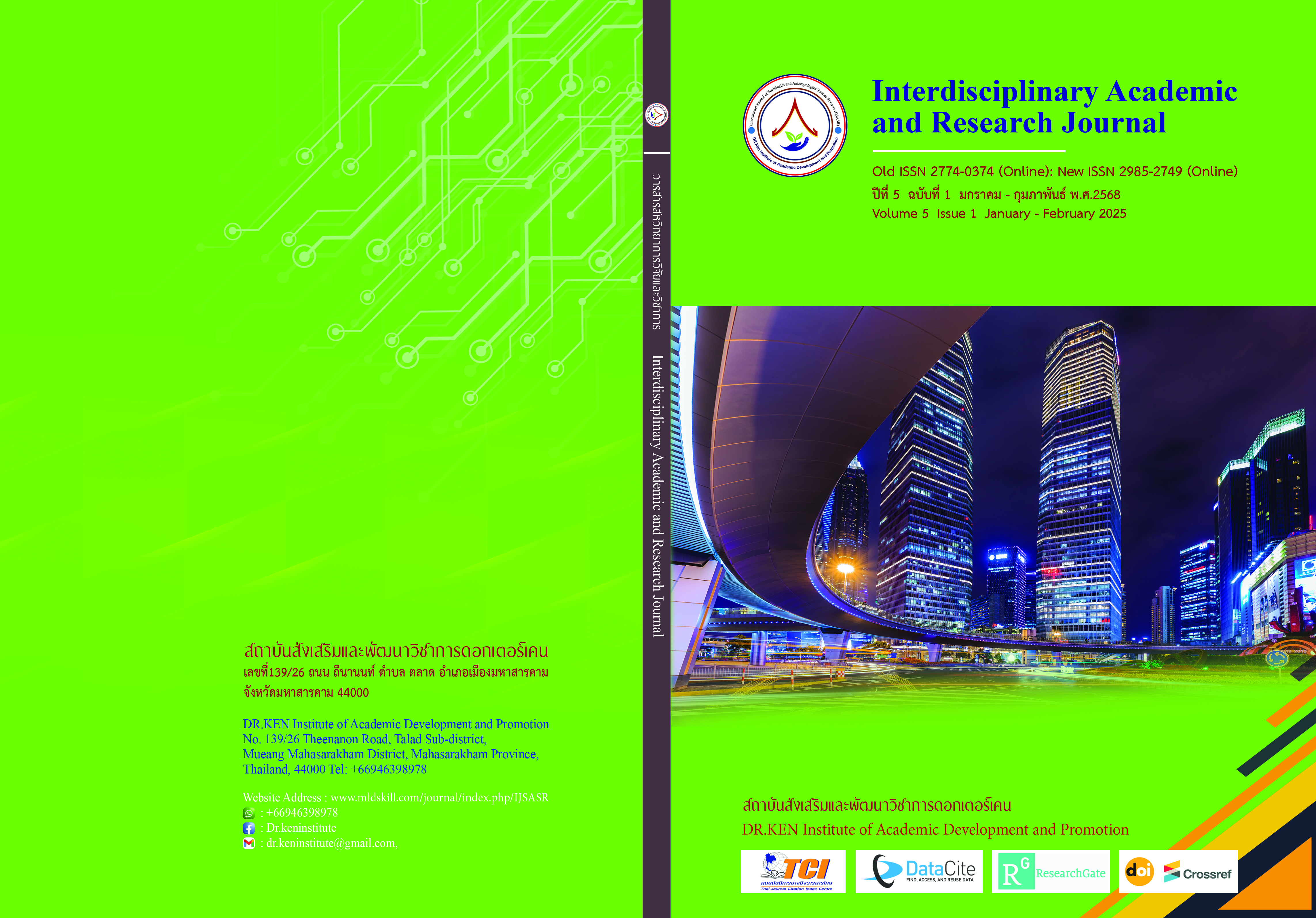Organizational Management and Organizational Culture that Affect the Effectiveness of Subdistrict Administrative Organization in Pathum Thani Province
DOI:
https://doi.org/10.60027/iarj.2025.280184Keywords:
Organizational management and organizational culture, Organizational effectiveness, Subdistrict administrative organizationAbstract
Background and Aims: Effective resource allocation, goal setting, and achievement are made possible by organizational management, which is essential to the success of the organization as a whole. Organizational culture improves performance and retention by creating a happy work environment, increasing employee engagement, and coordinating behavior with the goals and values of the business. The research aims to 1) study the level of organizational management and organizational culture of sub-district administrative organizations in Pathum Thani Province, 2) study the factors of organizational management and organizational culture that affect the effectiveness of the management of sub-district administrative organizations in Pathum Thani Province, and 3) propose guidelines for developing the efficiency of the management of sub-district administrative organizations in Pathum Thani Province.
Methodology: The sample group used in the research was 400 people aged 18 years and over living in the area of sub-district administrative organizations in Pathum Thani Province, obtained by using the Taro Yamane (Yamane. 1973: 725) sampling formula and simple random sampling. The qualitative data were collected by using a specific group of 11 informants. The research instruments were a 5-level rating scale questionnaire and an interview form. The statistics used for data analysis were frequency, percentage, mean, standard deviation, and correlation coefficient. Multiple regression analysis.
Results: The research results found that (1) The level of organizational management and organizational culture of sub-district administrative organizations in Pathum Thani Province was at a high level overall. When considering each aspect from highest to lowest, they were: coordination Command and control, planning, organization, and control, respectively. (2) The 13 organizational management and organizational culture factors that affect the effectiveness of the management of sub-district administrative organizations in Pathum Thani Province (Y) overall, regardless of the statistical significance of the variables, found that the coefficient of prediction was low (R2) equal to 0.177 or could predict only 17.7 percent, with statistical significance Sig. = 0.96, which is greater than .05, and there was high variability of data within and between groups, F = 76.6. (3) Suggestions for developing the efficiency of the management of sub-district administrative organizations in Pathum Thani Province The executives should have regular meetings between related agencies to create understanding and effective coordination. There should be a budget to support volunteers who join the work in various aspects, including public health, occupation, and economy.
Conclusion: The study found that organizational management and culture are generally high in sub-district administrative organizations in Pathum Thani Province, with the strongest characteristics being coordination and command. However, these variables only have a 17.7% predictive ability when it comes to management effectiveness. Among the suggestions are funding for volunteers in a variety of industries and improving interagency meetings for better coordination.
References
กรมส่งเสริมการปกครองส่วนท้องถิ่น. (2551). มาตรฐานกลางเพื่อการกำกับการดูแลองค์กร. กรุงเทพฯ: กรมส่งเสริมการปกครองส่วนท้องถิ่น.
เกศรา รักชาติ. (2549). องค์กรแห่งการตื่นรู้. กรุงเทพมหานคร: บริษัท เนชั่นมัลติมีเดีย กรุ๊ป จำกัด.
โกวิทย์ พวงงาม. (2544). การปกครองท้องถิ่นไทย. กรุงเทพมหานคร: บริษัทสำนักพิมพ์วิญญูชน จำกัด
จรัล สุวรรณมาลา.(2545). การกระจายอำนาจให้แก่องค์กรปกครองส่วนท้องถิ่น. กรุงเทพมหานคร: คุรุสภาลาดพร้าว.
ชนิดา จิตตรุทธะ. (2560). วัฒนธรรมองค์การ ปัจจัยสู่ความสำเร็จที่ยั่งยืน. พิมพ์ครั้งที่ 3. กรุงเทพฯ: จุฬาลงกรณ์มหาวิทยาลัย.
ทิพาวดี เมฆสวรรค์. (2538). การส่งเสริมประสิทธิภาพในระบบราชการ. กรุงเทพมหานคร : รักอ่าน.
ธงชัย สันติวงษ์. (2526). การบริหารงานบุคคล. กรุงเทพมหานคร: ไทยวัฒนาพานิช.
ธีระพล อรุณะกสิกร. (2550). รัฐธรรมนูญแห่งราชอาณาจักรไทย พุทธศักราช 2550. กรุงเทพมหานคร : วิญญูชน.
บรรจง อมรชีวิน. (2547). วัฒนธรรมข้ามชาติ. กรุงเทพฯ: ส. เอเชีย เพรส.
พิเชฐ ทรวงโพธิ์และคณะ. (2553). ความสัมพันธ์ระหว่าง รูปแบบวัฒนธรรมองค์กรกับแรงจูงใจในการท างานของบุคลากรกรมทรัพยากรน้ำบาดาล. วารสารบัณฑิตศึกษา มหาวิทยาลัยราชภัฎวไลยอลงกรณ์. 4(2), 1-14.
รุจารินทร์ จิตต์แกว้ และกิตติพันธ์คงสวัสดิ์เกียรติ. (2555). อิทธิพลด้านวัฒนธรรมองค์กรที่มีผลต่อ การสร้างแรงจูงใจในการปฏิบัติงานของภาคเอกชนในเขตกรุงเทพมหานคร. วารสาร การเงิน การลงทุน การตลาด และการบริหารธุรกิจ, 2(4), 102-120.
วิจารณ์ พานิช. (2550). วิถีแห่งองค์กรอัจฉริยะ. จุลสารอุตสาหกรรมสัมพันธ์. 73, 2-3.
สมยศ นาวีการ. (2541). การบริหารเชิงกลยุทธ์และนโยบายเชิงธุรกิจ. พิมพ์ครั้งที่ 4. กรุงเทพมหานคร: โรงพิมพ์ตะวันออก.
สมยศ นาวีการ. (2543). การบริหารและพฤติกรรมองค์การ. กรุงเทพมหานคร: โรงพิมพ์กรุงเทพมหานคร.
สมาน อัศวภูมิ. (2553). การบริหารการศึกษาสมัยใหม่: แนวคิด ทฤษฎี และการปฏิบัติ. พิมพ์ครั้งที่ 5. อุบลราชธานี: อุบลกิจออฟเซทการพิมพ์.
สำนักงานคณะกรรมการพัฒนาการเศรษฐกิจและสังคมแห่งชาติ. (2558). ทิศทางของ แผนพัฒนาเศรษฐกิจและสังคมแห่งชาติ ฉบับที่ 12. กรุงเทพฯ : สำนักงาน คณะกรรมการพัฒนาการเศรษฐกิจและสังคมแห่งชาติ.
องค์การบริหารส่วนตำบลในจังหวัดปทุมธานี. (2566). ข้อมูลพื้นฐาน. https://pathumpao.go.th/#
อภิญญา แจ่มแจ้ง. (2551). วัฒนธรรมองค์กรในองค์กรแห่งการเรียนรู้. วิทยานิพนธ์ กศ.ม.,มหาวิทยาลัยมหิดล, กรุงเทพฯ.
Cameron, K. S., & Quinn, R. E. (2011). Diagnosing and changing organizational culture: Based on the competing values framework. John Wiley & Sons.
Cronbach, L.J. (1974). Essentials of Psychological Testing. 3rd edition. New York: Harper and Row.
Daft, R. L. (2021). Organization theory and design. Cengage Learning.
Denison, D. R. (1996). What is the difference between organizational culture and organizational climate? A native's point of view on a decade of paradigm wars. Academy of Management Review, 21(3), 619-654. DOI: https://doi.org/10.5465/amr.1996.9702100310
Fayol, H.. (1930). Industrial and General Administration. New York: Mc-Grew Hill.
Gorton, R., Alston, J., & Snowden, P. (2006). School Leadership and Administration: Important Concepts, Case Studies and Simulations. Open University Press.
Jones, G. R., & George, J. M. (2021). Essentials of contemporary management. McGraw-Hill Education.
Katz, D., & Kahn, R. L. (1978). The social psychology of organizations. New York: Wiley.
Kotter, J. P. (1996). Leading change. Harvard Business Review Press.
Kotter, J.P., & Heskett, J.L. (1992) Corporate Culture and Performance. Free Press, New York.
Marcoulides, G.A., & Heck, R.H. (1993). Organizational culture and performance: Proposing and testing a model. Organization Science. 4 (2), 209‐25 DOI: https://doi.org/10.1287/orsc.4.2.209
Mayo, E. (1933). The Human Problems of an Industrial Civilization. New York: Macmillan.
Robbins, S. P., & Coulter, M. (2018). Management. Pearson.
Schein, E. H. (2010). Organizational culture and leadership. John Wiley & Sons.
Yamane, T.. (1973). Statistics: An Introductory Analysis. (3rd Ed). New York. Harper and Row Publications.
Yukl, G. (2013). Leadership in organizations. Pearson.
Downloads
Published
How to Cite
Issue
Section
License
Copyright (c) 2025 Interdisciplinary Academic and Research Journal

This work is licensed under a Creative Commons Attribution-NonCommercial-NoDerivatives 4.0 International License.
Copyright on any article in the Interdisciplinary Academic and Research Journal is retained by the author(s) under the under the Creative Commons Attribution-NonCommercial-NoDerivatives 4.0 International License. Permission to use text, content, images, etc. of publication. Any user to read, download, copy, distribute, print, search, or link to the full texts of articles, crawl them for indexing, pass them as data to software, or use them for any other lawful purpose. But do not use it for commercial use or with the intent to benefit any business.
















.png)


